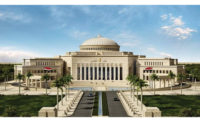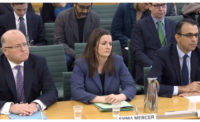Indian builders are racing against time to complete a new parliament building complex covering 64,500 sq m by Aug. 15, 2022, when the country celebrates the 75th year of its independence.
The $133 million building complex will be part of the $2.74 billion Central Vista government redevelopment in New Delhi, the nation’s capital. It will be a red sandstone building using stones extracted from the Dholpur mines of central India.
“The task of redeveloping the Central Vista is being undertaken with the objective of upgrading the environment around the parliament and improving facilities in the sprawling Central Vista Avenue. This redevelopment will be an important fulcrum of economic revival,” Hardeep Singh Puri, the minister for housing and works, told ENR.
The Central Vista houses important ministries including the office of the prime minister and will be the scene of major national events, including Republic Day celebrations. India obtained independence from British rule in 1947 and become a democratic republic, adopting a new constitution in 1950.
An Indian company, Tata Projects, won the bid for construction. Prime Minister Narendra Modi kicked off construction Dec. 10 with a stone-laying ceremony.
Architect Bimal Patel, who represents HCP Designs based in Ahmedabad city in western India, said the main building housing the parliament will be triangular, in reference to "sacred geometries in various religions and cultures of India.”
"In the Lok Sabha chamber, we have used the national bird (peacock) as the theme. In the Rajya Sabha, we have used the national flower (lotus) and in the central lounge we have used the national tree (banyan)," Patel said. India has two houses of parliament. The Lok Sabha is the elected house of parliament while members of the Rajya Sabha are indirectly elected and nominated.
The main building will be crowned with a round structure similar to India’s national emblem, which is a motif consisting of four lions riding a time-wheel showing 24 hours and 365 days of a year ,as used in 250 BCE by the then-Buddhist emperor Ashoka. The inside walls of the complex will be made of red granite. Special care will be undertaken to avoid damage to the environment during the construction phase, government sources said.
The complex will also include a central Constitution Hall, which will showcase the history and heritage of the country.
The new structure, which will rise up in front of the existing 94-year old parliament building, will have halls to sit 888 members of the Lok Sabha and 384 members of the Rajya Sabha with additional seating capacity of 1,272 persons.





Post a comment to this article
Report Abusive Comment